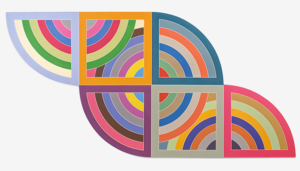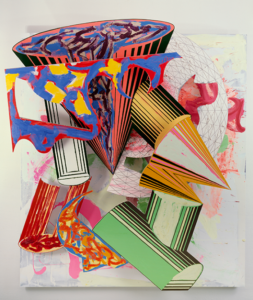
As Frank Stella turns 80 next year, a world — who knows him as the peerless modern painter,
innovator and pivotal influence to generations of artists after him — will come together with a world that
may not know him, yet. But both will be amazed and knocked out visually, by some of the best-known,
groundbreaking and boldest works by this seminal artist of the 20th century.
The Whitney Museum of American Art has bravely taken on and extensively strutted out the most
major pieces by this fiercely individualist artist, as Stella stands out on his own — with still brash and
explosive 2 and 3 dimensional work, giving the museum public a well-deserved and overdue
retrospective. A 5-year production in the making, with over 95 works of art, from 26 different series,
spanning 6 decades, giving back serious attention to one of the contenders of modern art, represented
in this expansive retrospective that just opened October 30th.

1978, Enamel Paint
As the center of Abstract Expressionism was occurring in NYC in the 1940s with Jackson Pollock,
Willem de Kooning and Franz Kline, leading a direction in experimenting with spontaneity, actionpainting
and rebellious anti-figurative representations of art, Frank Stella would later, in the 1950s, step
out of this movement and start another (along with Jasper Johns, Ellsworth Kelly and Robert
Rauschenberg). What you see on these walls are pioneering and radical transitions, from the very
early period of Stella’s work, minimalist, with his Black Paintings and Black, Cooper and Aluminum
series, with parallel stripes and darkness, and emerging layers, as the eye adjusts to a new approach
— namely East Broadway (1958) and later a signature piece from the Irregular Polygon series,
Harran II (1967), that abandon the confinement of frames but break out into linear, protractor-like,
intersecting lines and curves, all with wonderful bright Day-Glo colors of Pop-Art. And then there are
huge dimensional paintings/sculptures — shaped canvases, Gobba, zoppa e collotorto (1985). Oil,
urethane enamel, fluorescent alkyd and mixed materials that ushered in a whole muscular blast of
color and form — protruding out into the space of the viewer. The list of ingredients is part chemistry
lab and part junkyard. Stella is introducing non-painterly ingredients of aluminum, plastics, wood from
piping, metal from car doors, fiberglass siding, broken glass — all mixed with urethane enamel,
lacquer, fluorescent alkyd, acrylic — inorganic and organic — et al, creating an explosion with all these
materials, that introduces a 3-dimensional effect that dazzles — as it juts out to you, off the canvas, no
longer contained as a flat surface.

Stella’s prolific production, also evidenced in his depth of approximately 26 series of 2 and 3
dimensional styles, evolving over his on-going career, speaks to his creativity, ideas and contribution.
Facing this challenge, Adam Weinberg — the Alice Pratt Brown Director of the Whitney and Scott
Rothkopf — the Whitney’s Deputy Director for Programs and Chief Curator, had to address how to
properly represent such a vast but important range of this seminal artist’s work. At the press preview,
on October 28th, Mr. Weinberg posed a question, almost as a challenge, “Why hasn’t someone done a
retrospective on Frank Stella?”… “It is a massive body of work… at least 4 generations of artists have
entered Frank’s work along with 6 decades of commitment.”
In response , the Whitney’s exceptionally talented team succeeded, with vital contributions
recognizable from all. The management of gallery size, attention to exhibit detail and impeccable
hanging of the very smallest early minimalist paintings, to the very large multi-dimensional protruding
collage pieces of 10 feet by 10 feet, are testament to the museum putting to fantastic use the size and
space of their new super-sized gallery exhibit area (the Whitney just re-opened its doors this past May
of 2015, fronting a newly modernist building with glass and grey aluminum design, architecturally
enormous with 220,000 square feet, and a 422 million dollar investment).
Stella’s world takes us on his historical trip of modern art making — from his early influence from a
master teacher, Hans Hoffman, who would influence a whole school of Abstract Expressionism in NYC
in 1950s, to Stella’s intense drive throughout studio art classes at Princeton University, and his arrival
upon a blossoming art scene in NYC in 1958, surrounded by a hotbed of painters, artists, performers,
writers and musicians. Abstract Expressionist’s artwork was still the center of attention in galleries in
Greenwich Village and Soho. But Stella did not falter and remained in over-drive, first starting a studio
out of an old jewelry shop on the Lower East Side of Manhattan, in the bull’s eye of creative action. His
fierce personal and professional determination and individualism would see him make his mark.
Stella, from the very beginning, as stated in the Whitney press release, “began a profound engagement
with art making”, from minimalism pieces, multilayered, that force contrast to the eye, to geometrical
polygon visualizations that leave the boxed frame canvas behind, to mixed media 3 dimensional
projection assemblages that reaches out to you, and onto current work, incorporating entanglements of
sculptured bent tubing, stainless steel and aluminum with fiber, that provoke and poke you with their
physical size. Here is one man’s incredible collection of artistic statements spanning 6 decades. As
reflected by the Whitney Museum of American Art’s Chief Curator Scott Rothkopf, “this is an artist who
is not or has never been on auto-pilot.”
Come see a full appreciation of this seminal modern artist’s legacy in the grandeur and open space
that the Whitney Museum of American Art offers you to fully appreciate the magnitude, range and
power of Stella’s work. As one of the most influential modern artists of our time who, as re-emphasized
by Rothkopf, “avoided at all costs, an easy or elegant solution” to his work or direction in art — it will
not leave you in neutral

Come find and explore these provocative paintings and take on the artist’s own words, “There are two
problems in painting: One is to find out what painting is and the other is to find out how to make a
painting. The first is learning something and the second is making something.”
Don’t miss this chance to see the birth and breadth of this seminal modern artist’s work. ∎
Frank Stella: A Retrospective
(October 30, 2015 — February 7, 2016)
Whitney Museum of American Art
Address:
99 Gansevoort St
New York, NY 10014
United States

